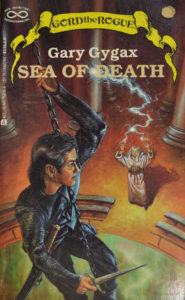 I recently finished a fantasy novel set in the Greyhawk universe, written by none other than Gary Gygax. It’s “The Sea of Death,” starring his character Gord the Rogue.
I recently finished a fantasy novel set in the Greyhawk universe, written by none other than Gary Gygax. It’s “The Sea of Death,” starring his character Gord the Rogue.
First off: It’s a rollicking D&D-esque adventure and a fun diversion.
However, it also contains a number of insights about how Gary expected D&D adventures to flow. A few lessons:
Groups of intelligent creatures don’t rush at each other on sight, even if both are enemies. They each send an envoy to size the other side up, and will retreat if the odds are overwhelming.
Every group of monsters–intelligent or not–will break and run if at least half of them die during an encounter (except in extremely rare circumstances). Gygax even has a magically animated statue surrender once one of its legs is broken. And while, yeah, that’s like the morale rules in early D&D, those just provided increased chances that enemies would run. Here, they always try to make a break for it when half their number die. Interesting.
I may have to bring back morale rules in my 5E games. Probably make it a collective Wisdom check vs. 10 as an initial rule.
Combat isn’t a matter of trading blows. While you are constantly swinging your sword or what-have-you, you’re more wearing your opponent down until you can get in a killing strike, and there’s plenty of fancy footwork and use of the environment. Sometimes combat feels surprisingly closer to a Jackie Chan movie than a Conan movie.
You can absolutely have unsavory things in your campaign world and keep them out of your campaign. Slavery exists and is consistently portrayed as odious, but in the story is mainly a thing that happens to other people or a threat if the heroes are captured.
Evil doesn’t win partly because evil characters are always plotting against each other to gain the ultimate victory for themselves. They can’t cooperate for long, and once one turns against another, that opens up opportunities for the heroes as long as the heroes continue to push against the villains.
